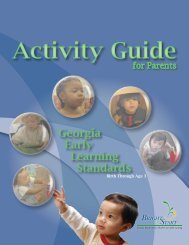Georgia's Pre-K Program - FPG Child Development Institute ...
Georgia's Pre-K Program - FPG Child Development Institute ...
Georgia's Pre-K Program - FPG Child Development Institute ...
Create successful ePaper yourself
Turn your PDF publications into a flip-book with our unique Google optimized e-Paper software.
Georgia Study of Early Care and Education: Findings from Georgia’s <strong>Pre</strong>-K <strong>Program</strong><br />
Comparative information is provided in Table 14. On some measures Georgia scored<br />
higher than Tulsa; whereas on other measures Tulsa appeared stronger. Past research<br />
has indicated that the CLASS Instructional Support is one of the most consistent<br />
predictors of children’s academic skills, and Tulsa’s pre-k classrooms were rated higher<br />
on this dimension than Georgia’s <strong>Pre</strong>-K classrooms.<br />
Table 14. Comparisons between Georgia’s and Tulsa’s <strong>Pre</strong>-K <strong>Program</strong>s<br />
Measure Georgia Tulsa, Oklahoma<br />
CLASS Emotional Climate 5.6–5.8 5.2<br />
CLASS Classroom Organization 5.4–5.6 5.0<br />
CLASS Instructional Support 2.3 3.2<br />
Snapshot Literacy Activities 17% 30%<br />
Snapshot Math Activities 15% 17%<br />
Snapshot Science Activities 8% 17%<br />
Snapshot Social Studies Activities 16–18% 13%<br />
Snapshot Art Activities 15–25% 18%<br />
Note: The Tulsa, Oklahoma research project gathered data in almost all of the morning pre-k classes in Tulsa<br />
(n = 77). Almost all of the pre-k classes were in public schools. The CLASS and the literacy, math, science, social<br />
studies and art learning activity codes for the Snapshot were completed.<br />
Differences in funding levels may at least partially explain the quality differences<br />
between Tulsa’s and Georgia’s <strong>Pre</strong>-K programs. Although the state of Oklahoma<br />
spends only $3,966 per child in pre-kindergarten, those funds are supplemented with<br />
local and federal dollars to bring the total amount spent per child to $7,484. 21 Georgia<br />
spends about $4,200 per child for its pre-kindergarten program, and Georgia’s <strong>Pre</strong>-K<br />
<strong>Program</strong> does not have additional local or federal funding. Thus, the total per child<br />
expenditure in Georgia is only 57% of that in Oklahoma.<br />
Improving the quality of Georgia’s <strong>Pre</strong>-K <strong>Program</strong> will require greater<br />
investments. As noted above, Georgia spends about $4,200 per child for its prekindergarten<br />
program. The estimate of the per-child cost of providing a high quality<br />
pre-k program in Georgia is nearly twice that amount ($7,882). 22 Additional resources<br />
are likely needed—from federal, state, or local sources—if Georgia’s <strong>Pre</strong>-K <strong>Program</strong><br />
intends to meet its goal of offering high quality early care and education to four-yearolds<br />
in the state.<br />
Although multiple strategies are needed, professional development (e.g.,<br />
training and technical assistance) is important for improving the quality<br />
of care and education for Georgia’s pre-kindergartners. Multiple strategies<br />
will likely be needed to raise the quality of Georgia’s <strong>Pre</strong>-K <strong>Program</strong>. Georgia’s<br />
<strong>Pre</strong>-K leaders will need a focused and coordinated set of policies, teacher supports,<br />
and resources to improve quality. In-service training and technical assistance are<br />
important components of a set of strategies to strengthen the pre-k program.<br />
25
















